![]()
![]()
![]()
Use LEFT and RIGHT arrow keys to navigate between flashcards;
Use UP and DOWN arrow keys to flip the card;
H to show hint;
A reads text to speech;
57 Cards in this Set
- Front
- Back
|
epithelial tissue |
lining of organs, protection |
|
|
simple squamous epithelium |
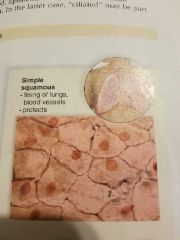
layer of thin, flat cells that lines internal cavities, the heart, and blood vessels |
|
|
skeletal muscle |
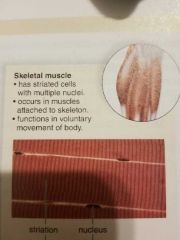
muscles attached to bones - voluntary contraction, striated |
|
|
cardiac muscle |

found only in the heart, involuntary,, branching, striated cells |
|
|
smooth muscle |

internal organs, involuntary |
|
|
motor neurons |
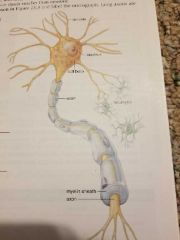
take messages from spinal cord to muscles |
|
|
connective tissue |
connects different parts of the body together - bone, blood, cartilage, proper connective tissue |
|
|
loose fibrous connective tissue |
supports epithelium, internal organs, muscles, and nerves |
|
|
dense fibrous connective tissue |
tendons, ligaments, connects bones and muscles |
|
|
adipose tissue |
fat storage, insulation, protection |
|
|
compact bone |
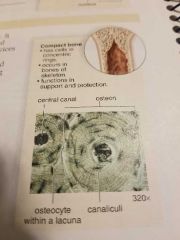
central canal - contains nerve and blood vessels |
|
|
hyaline cartilage |
in nose and walls of respiratory passages |
|
|
red blood cells |
bioconcave, no nucleus, carry oxygen |
|
|
white blood cells |
larger, have a nucleus, fight infection |
|
|
pseudostratified ciliated columnar epithelium |
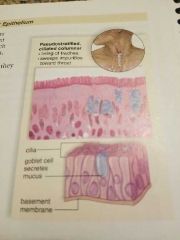
cilia on the end of each cell lining of trachea - protects lungs, moves mucus |
|
|
simple columnar epithelial |
tall, column like cells with nucleus at base, lines digestive tract + uterus, absorbs nutrients and protects |
|
|
simple cuboidal epithelial |
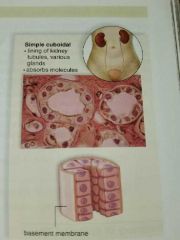
single layer of cube shaped cells found in the kidney and gland ducts, secretes mucus and protects |
|
|
chi square value |
= sum of (difference in observed and expected value)^2 /expected value |
|
|
mRNA |
messenger RNA - carries code from DNA to ribosomes |
|
|
transcription |
complementary mRNA is made from a DNA template - RNA polymerase |
|
|
codon |
set of three bases in mRNA |
|
|
anticodon |
complementary to codons |
|
|
gel electrophoresis |
separates molecules by charge and size (used in forensic science) |
|
|
ectoderm |
forms the nervous system and skin in embryos |
|
|
endoderm |
germ layer - forms lining of digestive and respiratory system |
|
|
mesoderm |
germ layer - forms cardiovascular, muscular, reproductive, and skeletal systems |
|
|
morula |
stage if zygote division - ball of cells about same since as original zygote |
|
|
blastula |
zygote division - single layered ball of cells with blastocoel in middle |
|
|
early gastrula |
blastula folds inward to form two layered gastrula - outer layer is ectoderm, inner layer is endoderm |
|
|
nondusjunction |
-homologues fail to separate during meiosis I or II |
|
|
extraembryonic membranes |
chorion, amnion, yolk sac, allantois |
|
|
chorion |
humans- forms fetal portion of placenta, absorbs nutrients from mother chick- gas exchange |
|
|
amnion |
contains amniotic fluid |
|
|
yolk sac |
chick - surrounds yolk mammals - first blood cell formation |
|
|
allantois |
chick - storage area for waste human - part of umbilical cord |
|
|
induction |
induces formation of nervous system |
|
|
oral cavity |
tongue and teeth |
|
|
glottis |
opening through which air passes to the trachea |
|
|
epiglottis |
flap that covers epiglottis |
|
|
thoracic cavity |
heart and lungs |
|
|
thymus gland |
lymphatic system, white blood cells |
|
|
abdominal cavity |
liver, spleen, intestines, stomach, kidneys |
|
|
liver |
largest organ in abdomen, disposes of old blood cells and produces bile |
|
|
spleen |
long flat organ connected to stomach, purifies blood |
|
|
gallbladder |
stores and releases bile |
|
|
axial skeleton |
skill, spine, ribs |
|
|
pectoral girdle |
clavicle and scapula |
|
|
arm bones |
humerus, radius, ulna, carpals, metacarpals, phalanges |
|
|
flexion |
movement of joints toward each other |
|
|
abduction |
movement of part away from body |
|
|
isometric contraction |
length of muscle does not change |
|
|
sarcomere |
unit of muscle |
|
|
mitosis |
1 diploid cell makes 2 diploid |
|
|
meiosis |
1 diploid makes 4 haploid |
|
|
prophase 1 |
chromosomes line up, crossing over |
|
|
metaphase I |
homologous chromosomes line up at center of cell, spindle attaches |
|
|
skin |
stratified squamous epithelial cells |

